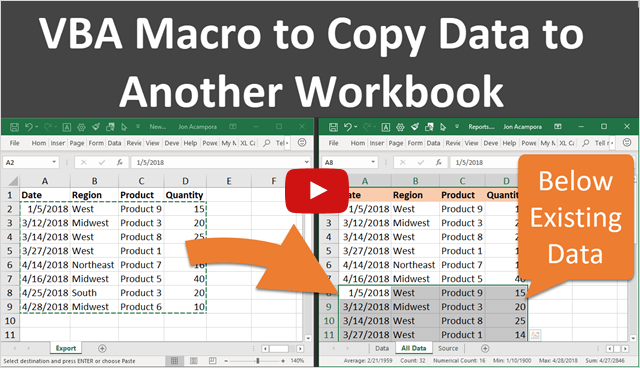

- #Import data from excel to excel using macro how to#
- #Import data from excel to excel using macro update#
- #Import data from excel to excel using macro full#
- #Import data from excel to excel using macro code#
I'm so sorry that this question is too long.
#Import data from excel to excel using macro how to#
I have no idea how to make any change to let me select what I want to import.Īnyone can give me some advice of how to achieve my goal? It works fine, but it is strictly to the specific file name and location. You can use the ImportExportSpreadsheet macro action to import or export data between the current Access database (.mdb or. "OLEDB Provider=.1 Data Source=$Workbook$ Location=NewTest1 Extended Properties=""""" _ Set sSht = ThisWorkbook.Sheets(sSheetName)ĬhkWorkSheetExists = Not sSht Is Nothing ' Return true is worksheets Name:="NewTest1", Formula:= _ Range("A1")�įunction chkWorkSheetExists(sSheetName As String) As Boolean UsedRange.Copy _ĭestination:= ThisWorkbook.Sheets(objSourceWs.Name). ' If worksheet does not exists, create a new worksheet. If Not chkWorkSheetExists(objSourceWs.Name) Then ' Check if worksheet exists in the destination file (the current workbook).

' Pull data from all work sheets in the source file. However, the method that I am sharing here is slightly different from the first two examples that I have explained above.ĭim objSourceWs As Worksheet ' Create worksheet object. The macro to pull data from multiple sheets from another workbook is very simple. Macro to Pull Data from Multiple Sheets from another Workbook 👉 Now, if you want to pull data from multiple files and show it in a single file but different sheets, you should read this post. The FileDialog() method remains the same. I have used the Range() method in this example, to specify the range from where I’ll pull the data. Close False ' False, so you don't save the source file. Cells(Rows.Count, "B").End(xlUp).Row).Rows.CountĬells(iCnt, 1) = src. Let us assume you want to pull or extract data from the 2nd column (B column) in Sheet1 only. However, you can limit the amount of data that you want to extract from the source file. It doesn’t matter how many tables you have in the source file. To do this, I am using the UsedRange property. In the first example above, I am pulling data from every row and column in Sheet1. You may also like: 👉 How to read Data from a Closed Excel file or Workbook without actually opening it Pull only a Specific Range of Data from another Workbook Once I have access to the Excel file, I’ll get the total row and column count and read all the table data in the file. Set src = Workbooks.Open(sTheSourceFile, True, True) ' Open the source file. It’s in readonly state, which means, during this whole process, you cannot do anything in the source file even if its open. You must set the value as true after executing the code.
#Import data from excel to excel using macro update#
Setting this property value as false ensures that the macro (or the code) runs fast and smooth, since it will not update the screen. Now, look at this property Application.ScreenUpdating, which I have set as “false”.
#Import data from excel to excel using macro full#
The procedure takes a parameter (or an argument), the source file name and its full path. What’s inside the procedure readExcelData().
#Import data from excel to excel using macro code#
Next, I am calling the “readExcelData()” procedure, where I have the code to read the source file. I can select a workbook from anywhere in the computer. Src.Close False ' False, so you don't save the source file.įirst, I am creating a FileDialog object to open a file dialog box. ' Now, read the source and copy data to the master file.Ĭells(iRows + iStartRow, iCols) = src.Worksheets("Sheet1").Cells(iRows, iCols) ĭim iColumnsCount As Integer ' Get the total Columns in the source file. Open(sTheSourceFile, True, True) ' Open the source file.ĭim iRowsCount As Integer ' Get the total Used Range rows in the source file.

ScreenUpdating = False ' Do not update the screen. Add "Excel Files", "*.xlsx?", 1Īpplication.


 0 kommentar(er)
0 kommentar(er)
